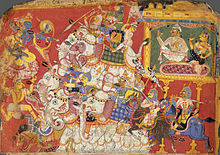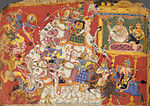This article may lend undue weight to certain ideas, incidents, or controversies. (October 2024) |
| Narakasura | |
|---|---|
 | |
| Information | |
| Gender | Male |
| Spouse | Maya (Princess of Vidarbha) |
| Children | Bhagadatta (Son) |
| Relatives | |
| Dynasty | Bhauma |
| Part of a series on |
| Vaishnavism |
|---|
 |
| Part of a series on the |
| Mythology of Pragjyotisha |
|---|
 |
| Ruling dynasties |
Naraka, also known as Narakasura, and Bhaumasura was an asura king, the legendary progenitor of all three dynasties of Pragjyotisha-Kamarupa, and the founding ruler of the legendary Bhauma dynasty of Pragjyotisha.[1][2][3] Though the myths about Naraka are first mentioned in the Mahabharata,[4] later texts embellish them.[5] According to later post-Vedic texts such as the Brahma Purana and Vishnu Purana, he was the son of Bhudevi,[6] fathered either by the Varaha incarnation of Vishnu.[7] He is claimed as one who established Pragjyotisha. He was slain by Krishna and Satyabhama. His son Bhagadatta—of Mahabharata fame—succeeded him.
The 10th/11th-century Kalika Purana embellishes the myths further and he is claimed to have come from Mithila and said to have established the kingdom of Pragjyotisha after overthrowing the last of the Kirata kings, Ghatakasura, of the Danava dynasty.[8] It was foretold that he would be destroyed by a later incarnation of Vishnu. His mother, the earth, sought the boon from Vishnu that her son should have a long life, and that he should be all-powerful. Vishnu granted these boons.[9]
The legends of Naraka is important in the history of Assam, particularly Kamarupa; since Narakasura is cited as the progenitor of all three dynasties that ruled Kamarupa in historical times. A hill, to the south of Guwahati is named after him.[10] He is also associated with the Hindu belief of the shakti goddess and place of worship Kamakhya.[11]
- ^ "Pragjyotisha and Pragjyotishapura, which are names of the capital city situated about Guwahati, are mentioned for the first time in the Mahabharata and the Ramayana in connection with the mythical kings Naraka, his son Bhagadatta and latter's son Vajradatta all of whom bear Sanskrit names." (Sircar 1990:80)
- ^ Dalal, Roshen (2010). Hinduism: An Alphabetical Guide. Penguin Books India. ISBN 978-0-14-341421-6.
- ^ "(I)n the inscriptions issued by the rulers of Pragjyotisa-Kamarupa from the 4th to the 12th century A.D. it has been claimed that the founders of the respective dynasties belong to the Naraka line of kings." (Boruah 2005:1465)
- ^ "The earlier stage of the myths of Naraka and his son and his grandson is found in the Mahabharata" (Sircar 1990:82)
- ^ (Sircar 1990:84)
- ^ "Naraka is not mentioned (in the Mahabharata) as the son of the Earth...so that the said development in other works must be regarded as a later fabrication" (Sircar 1990:83)
- ^ Tiburtius, Barnabas (10 March 2020). Symbols and Themes in Sacred Texts: Self Empowering Wisdom – Volume 3. Notion Press. ISBN 978-1-64760-839-2.
- ^ Kali Prasad Goswami (2000), Devadāsī: Dancing Damsel, p.28 Pragjyotish can be regarded as a Dravida country that was overthrown by the Mongoloid people. Naraka regained this kingdom and drove away from the Mongoloids. According to the Kalika Purana, when Naraka developed demonic qualities Vishnu was invited to kill him. In due course, he came and killed Naraka and enthroned Bhagadatta. This Bhagadatta again introduced the Saiva cult in Pragjyotisha.
- ^ George M. Williams (2008), Handbook of Hindu Mythology, p.222
- ^ Siba Pada Sen (1980), Sources of the history of India - Volume 3, p.69
- ^ "Legends of Kamakhya festivity". The Statesman. 9 October 2017. Retrieved 9 June 2020.